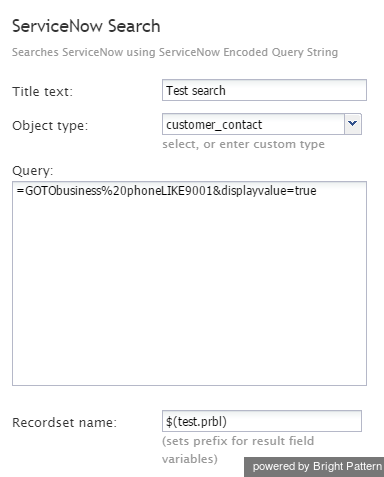ServiceNow Search
The ServiceNow Search scenario block is used to obtain ServiceNow data. The block executes the specified ServiceNow record selection statement written in the ServiceNow Encoded Query String.
The columns of the first record of the retrieved recordset are stored in variables <recordset_name>.<column_name>. For that statement, the results will be stored in variables Recordset.id and Recordset.name.
The number of returned records is stored in variable <recordset_name>.__count__ (e.g., RS.__count__.). Note the double underscores in front and after count; they are used to reduce the chance of confusing the name of this variable with a column name in a recordset.
To iterate through the recordset, use the Get Next Record block.
Conditional Exits
The ServiceNow Search block may take one of the following conditional exits: Failed or No Data.
Failed
The Failed conditional exit is executed if the search operation failed.
No data
The No data conditional exit is executed if no data matching the specified search criteria is found.
Settings
Title text
Title text is the name of the instance of the block. Enter a name in the text field and click the Update button at the bottom of the Edit pane. The new name of the block appears in the flowchart.
Object type
Object type is the type of object (e.g., “problem” or “incident”). It is selected from the drop-down menu or entered manually as a custom object.
Query
Query is the record selection statement. It may contain application variables specified as $(varname).
Recordset name
Recordset name is the name of the recordset that will be retrieved via this search operation. The recordset name is the same as the value that you entered for Variable name of object ID in the ServiceNow Create Object block.
The code and the body of the received HTTP response is stored in local variables $(integrationResultCode) and $(integrationResultBody) respectively. For troubleshooting purposes, use the EMail or Internal Message block to obtain content of responses indicating a failed search attempt. For more information, see the description of the variable $(integrationResultBody).

